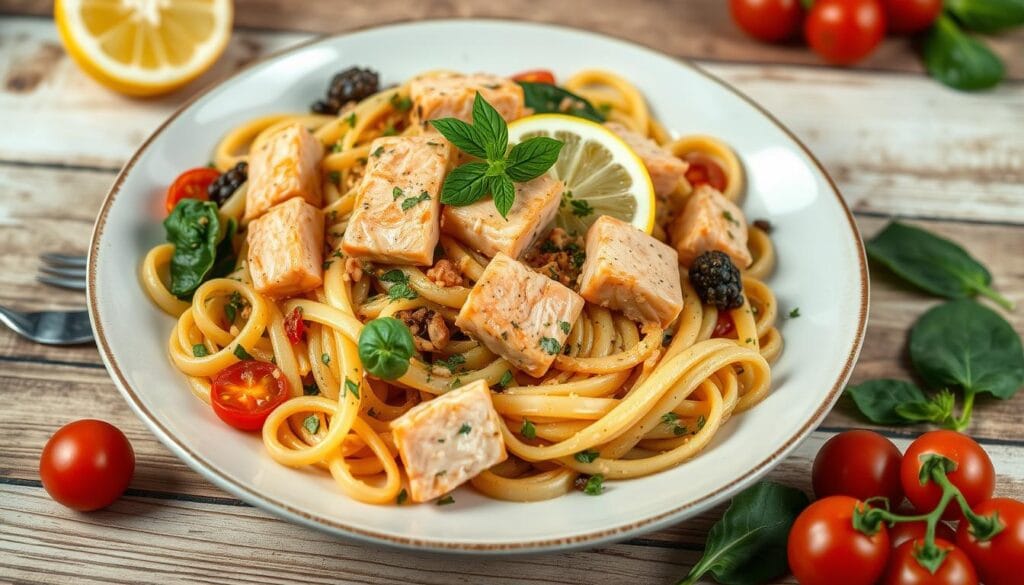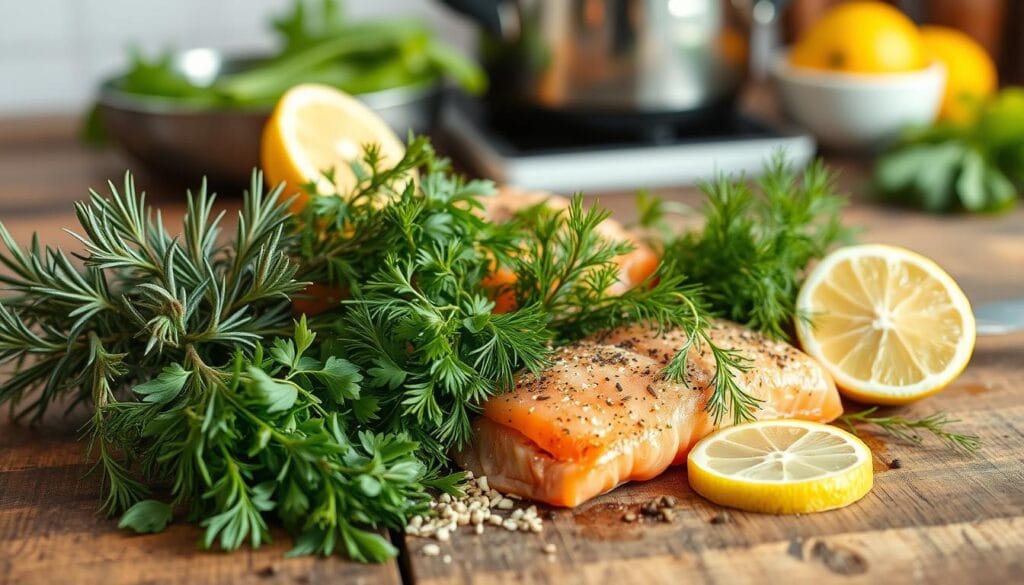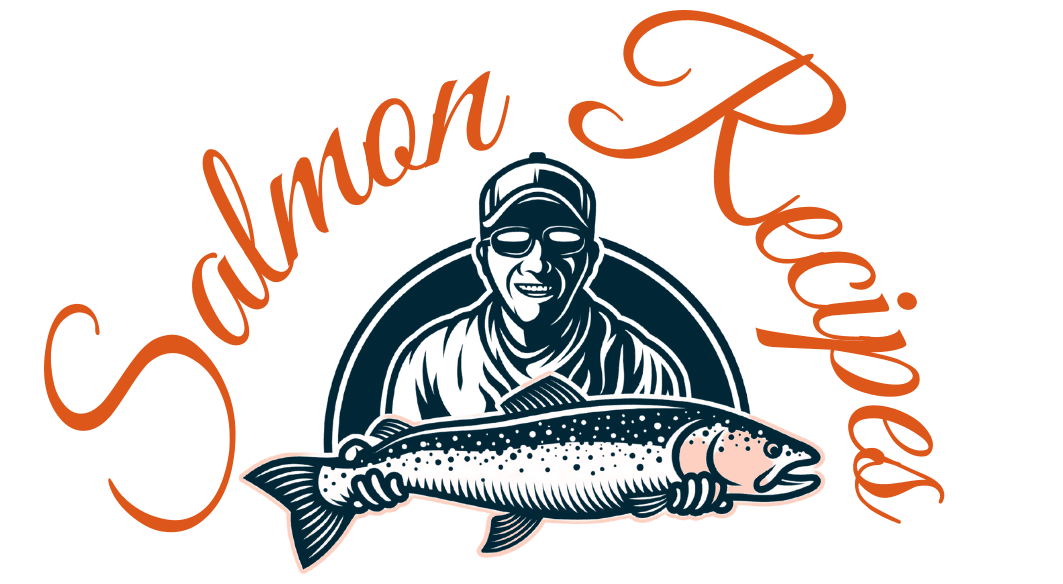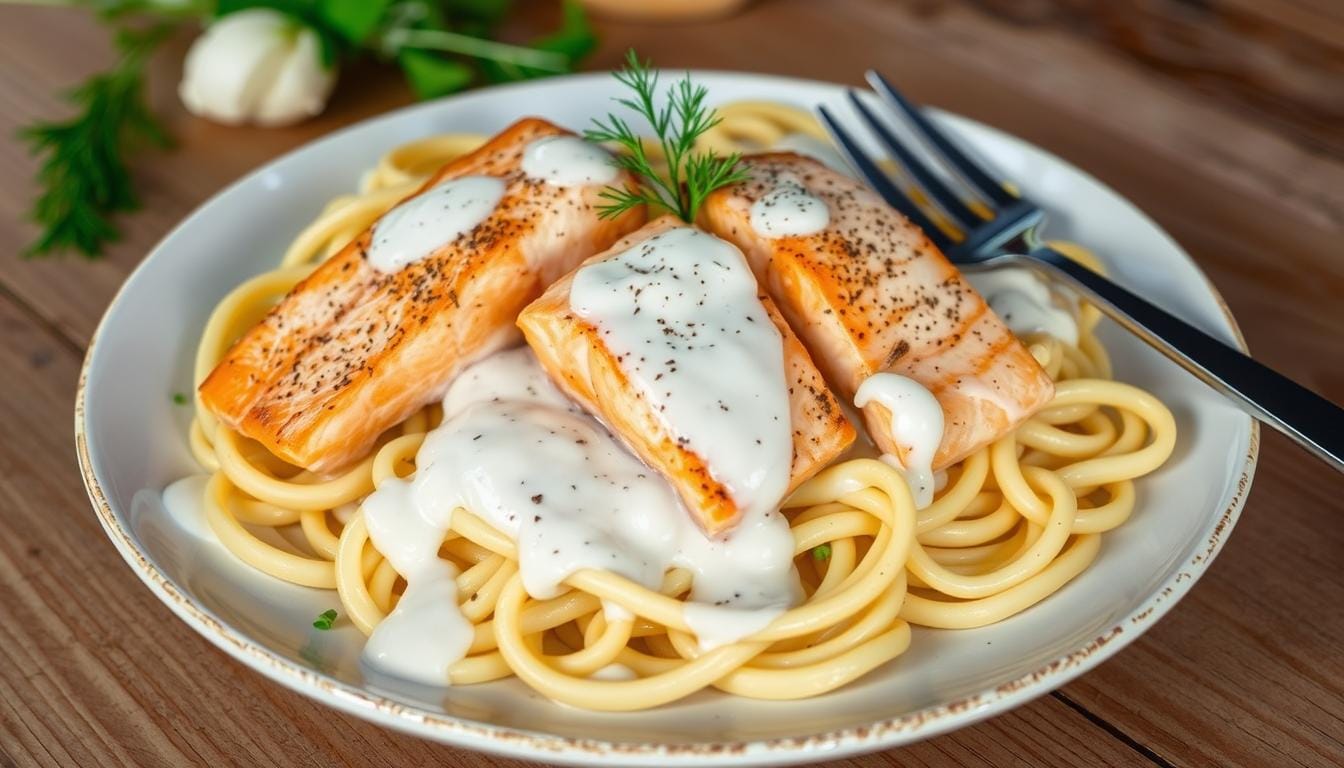Table of Contents
Looking for a tasty salmon and pasta recipe that’s quick? You’re in luck! This easy dinner idea is ready in just 30 minutes. It’s perfect for busy cooks who want a top-notch meal without spending hours cooking.
This creamy salmon pasta recipe uses only 8 simple ingredients. It turns weeknight cooking into a fun experience. Whether it’s for family dinner or a special meal, this dish is full of flavor and easy to make.
Our recipe ensures wild-caught salmon is cooked just right in a creamy sauce over al dente pasta. The best part? You can have a gourmet meal ready faster than ordering takeout. Each bite is packed with nutrition and amazing taste.
Get ready to wow your dinner guests with this quick salmon and pasta recipe. It shows that fast meals can be both delicious and elegant.
Why This Salmon and Pasta Recipe Is Perfect for Weeknight Dinners
Finding a quick, healthy meal that tastes great can be tough. This salmon and pahttps://quicksalmonrecipes.com/easy-salmon-fish-tacos/sta recipe is a winner for busy cooks. It’s both tasty and easy to make.
Time-Saving Benefits
Need a quick dinner for weeknights? This recipe is your answer! It’s ready in just 30 minutes. It’s perfect for families and busy professionals.
- Prep time: 15 minutes
- Cooking time: 15 minutes
- Single pan preparation
- Minimal kitchen cleanup
Nutritional Value and Health Benefits
This dish is full of omega-3s, making it super nutritious. Salmon is great for your heart and brain. Here’s what you get in each serving:
| Nutrient | Amount |
|---|---|
| Calories | 515 kcal |
| Protein | 18g |
| Carbohydrates | 60g |
| Fat | 21g |
Cost-Effectiveness
Eating out can be pricey. But this salmon pasta recipe is a budget-friendly option. You can make it at home and save money. Plus, it’s made with affordable ingredients.
“Cooking at home isn’t just about saving money—it’s about creating nutritious, delicious meals that bring families together.”
Essential Ingredients for Your Creamy Salmon Pasta
To make a true Italian dish, start with the right ingredients. Fresh salmon is key, adding flavor and nutrients to your meal.
- Fresh salmon (8 ounces/225g) – Pick high-quality, wild-caught salmon for the best taste
- Pasta (8 ounces) – Linguini, spaghetti, or tagliatelle are great choices
- Heavy cream (¾ cup/180ml) for a creamy sauce
- Olive oil for authentic Italian cooking
- Fresh garlic
- Lemon for a burst of freshness
- Fresh herbs like oregano and thyme
When picking your salmon, look for bright, firm flesh and a clean smell. The quality of your ingredients affects your dish’s taste.
“In Italian cooking, fresh ingredients are the secret to an extraordinary meal.” – Italian Culinary Tradition
Nutritional highlights for your salmon pasta include:
- Protein: 23g per serving
- Calories: 374 kcal
- Carbohydrates: 45g
- Healthy fats: Omega-3s from fresh salmon
Pro tip: Always choose ingredients at their freshest to get the best taste and experience.
Kitchen Tools and Equipment Needed
Creating tasty pasta dishes and seafood recipes needs the right tools. Before starting your salmon pasta, let’s look at the essential kitchen equipment you’ll need. This will make cooking easier and more fun.
Basic Cookware Requirements
To make your salmon pasta just right, you’ll need these basic tools:
- Large pot for boiling pasta
- Skillet or sauté pan for cooking salmon
- Sharp chef’s knife
- Cutting board
- Measuring cups and spoons
- Wooden spoon or silicone spatula
Optional Equipment for Enhanced Results
These extra tools can make your seafood and pasta dishes even better:
- Zester for fresh lemon zest
- Fish spatula for delicate salmon handling
- Digital meat thermometer to check salmon doneness
- Kitchen timer for precise cooking
“The right tools can transform a good recipe into a great meal.”
Quality cookware makes cooking seafood recipes more fun. It also helps you get great results every time.
Step-by-Step Cooking Instructions
Making a great salmon and pasta dish needs attention to detail. This guide will help you through each step. You’ll learn how to make a tasty lemon garlic sauce and cook the salmon just right.
- Pasta Preparation
- Start by boiling a large pot of salted water.
- Cook 8 ounces of spaghetti until it’s al dente, which takes 10-13 minutes.
- After cooking, drain the pasta and keep 1/4 cup of pasta water aside.
- Salmon Cooking
- Pat the salmon dry with paper towels.
- Season it with salt and pepper.
- Heat 1 tablespoon of olive oil in a skillet.
- Cook the salmon for 3-4 minutes on each side until it’s 145°F inside.
- Lemon Garlic Sauce Creation
- In the same skillet, melt 1 tablespoon of butter.
- Sauté 3 minced garlic cloves.
- Whisk in 1 tablespoon of flour.
- Slowly add 3/4 cup of heavy cream.
- Stir in 1 tablespoon of lemon juice.
- Add 1/2 cup of grated parmesan.
- Final Assembly
- Gently flake the salmon.
- Toss the pasta with the lemon garlic sauce.
- Fold in the salmon pieces.
- Garnish with fresh parsley.
“The key to a great salmon and pasta recipe is timing and temperature control.” – Culinary Chef
Your lemon garlic sauce should coat the pasta smoothly. This makes a creamy and flavorful dish ready in just 30 minutes.
Choosing the Perfect Salmon for Your Pasta Dish
Choosing the right fresh salmon is key to making tasty seafood recipes. The salmon you pick can greatly affect your pasta dish’s flavor and quality.
Wild-Caught vs. Farm-Raised Salmon Options
You’ll find two main types of salmon: wild-caught and farm-raised. Wild-caught salmon usually tastes better and is healthier:
- More omega-3 fatty acids
- Deeper, more natural taste
- Leaner and less fatty
- Caught in the wild, not farmed
How to Select Fresh Salmon
Choosing top-notch fresh salmon needs a careful eye. Here’s what to look for:
- Uniform color, no brown or gray spots
- Firm flesh that bounces back
- Clean smell, no strong fish smell
- Looks moist, no liquid pooling
Salmon Storage Tips
Storing salmon right keeps it fresh and safe to eat. Here’s how to keep your seafood at its best:
| Storage Location | Duration | Recommended Temperature |
|---|---|---|
| Refrigerator | 1-2 days | Below 40°F |
| Freezer | Up to 1 month | 0°F or lower |
“Fresh salmon is the cornerstone of an exceptional seafood recipe. Choose wisely, and your pasta dish will shine!” – Culinary Expert
By picking the right salmon and storing it correctly, your salmon pasta will always taste great.
Best Pasta Types for This Recipe

Choosing the right pasta is key to making tasty pasta dishes in Italian cuisine. Long, flat pasta cuts are best with creamy salmon recipes. They ensure the sauce covers the pasta well and feels right in your mouth.
Here are the top pasta picks for your salmon pasta:
- Linguine: Perfect for creamy sauces
- Fettuccine: Great for sauces sticking to it
- Spaghetti: A classic for creamy sauce
- Pappardelle: Wide noodles for thick sauces
Different pasta shapes work differently with sauces. Flat, long noodles have a smooth surface. This lets creamy sauce stick well to each strand. You’ll get a balanced bite with salmon and sauce in every forkful.
“The right pasta transforms a good dish into an extraordinary culinary experience.” – Italian Cooking Wisdom
If you follow a gluten-free diet, there are great alternatives. Chickpea or rice pasta works well. They keep the dish tasty while meeting dietary needs.
Pro tip: Cook your pasta one minute less than the package says. This makes it al dente, which pairs great with your salmon cream sauce.
Creating the Perfect Lemon Garlic Cream Sauce
A top-notch lemon garlic sauce can make your salmon pasta truly special. This sauce is creamy and vibrant. It combines rich flavors that match the salmon’s delicate taste perfectly.
To make a smooth sauce, focus on the texture. It should stick well to your pasta and salmon. The trick is to mix the citrusy lemon with the warm garlic.
Key Ingredients for the Sauce
- 4 cloves of fresh garlic, minced
- 2 tablespoons fresh lemon juice
- Lemon zest from 1 small lemon
- ¾ cup whipping cream
- ½ cup chicken stock
- Parmesan cheese for extra richness
Sauce Consistency Tips
Getting the sauce right needs careful temperature control. Start by cooking minced garlic in butter for 30 seconds. This releases its oils. Then, add cream and stock slowly. Let it simmer for 5-6 minutes until it thickens.
“The secret to a great cream sauce is patience and gentle heat.”
When adding parmesan cheese, grate it finely and add it slowly. This prevents clumps. The cheese adds flavor and makes the sauce silky and luxurious.
| Ingredient | Quantity | Purpose |
|---|---|---|
| Garlic | 4 cloves | Provides deep, aromatic flavor |
| Lemon Juice | 2 tablespoons | Adds bright, citrusy notes |
| Whipping Cream | ¾ cup | Creates smooth, rich texture |
| Parmesan Cheese | 2-3 tablespoons | Enhances flavor and thickness |
The aim is for a sauce that’s creamy but light. It should have a perfect mix of garlic and lemon. This will take your salmon pasta to a gourmet level.
Tips for Perfectly Cooked Salmon
Cooking fresh salmon needs precision and care. The secret to a tasty salmon dish is knowing the best cooking method and temperature.
Here are some key tips for cooking salmon:
- Bring salmon to room temperature before cooking (15-20 minutes)
- Cook salmon to an internal temperature of 145°F
- Check doneness using the flake test
- Avoid overcooking to maintain moisture
The flake test is a simple way to check if your salmon is cooked right. Gently press the salmon with a fork. If it easily separates and looks opaque with a slightly translucent pink center, it’s ready to serve.
“The difference between good and great salmon is just a few minutes of cooking time.” – Professional Chef
Baking salmon usually gives the best results. At 400°F, a salmon fillet takes 12-15 minutes to cook. For thinner fillets, cook for 8-10 minutes.
Pro tip for seafood recipes: Let your salmon rest for 2-3 minutes after cooking. This helps the juices spread, making the dish moist and flavorful.
Herb and Seasoning Combinations
Making a tasty Italian dish means finding the perfect mix of herbs and seasonings. Your salmon pasta can go from good to great with the right herbs. These herbs boost both flavor and health in your meals.

Choosing the right herbs is key to a great dish. Fresh and dried herbs each add something special to your meal.
Fresh vs. Dried Herbs: Flavor Profiles
For your salmon pasta, you have two main herb choices:
- Fresh herbs: They have a bright, strong taste
- Dried herbs: They pack a more intense flavor that lasts longer
Recommended Herb Combinations
| Herb Type | Flavor Profile | Recommended Quantity |
|---|---|---|
| Dried Oregano | Earthy, slightly bitter | 1-2 teaspoons |
| Dried Thyme | Minty, subtle warmth | 1-2 teaspoons |
| Dried Rosemary | Pine-like, aromatic | 1 teaspoon |
| Fresh Basil | Sweet, peppery | 2 tablespoons, chopped |
Seasoning Measurements and Tips
Here are some tips for seasoning your salmon pasta:
- Begin with small amounts
- Keep tasting and adjust as needed
- Use fresh herbs for garnish
- Dried herbs are best when added while cooking
“The right herb can turn a simple meal into a culinary masterpiece.”
Try out different herb mixes to find your favorite seasoning for salmon pasta. This way, you can enjoy the rich flavors of Italian cuisine while keeping your meals healthy.
Storage and Reheating Guidelines
Keeping your pasta dishes fresh is key. Proper storage helps you enjoy your salmon pasta for days after you make it.
- Use an airtight container to keep it fresh
- Put it in the fridge within 2 hours of cooking
- It stays good for 3-5 days in the fridge
Reheating needs care to keep the dish tasty and moist. Here’s how to do it right:
- Warm it up in a saucepan over medium heat
- Add a bit of cream or pasta water to avoid dryness
- Heat it in short bursts of 20-30 seconds
“The key to great leftovers is gentle reheating and added moisture.”
Freezing is not the best option for this pasta dish. The cream sauce might separate when thawed, ruining the dish’s quality.
| Storage Method | Duration | Best Practices |
|---|---|---|
| Refrigerator Storage | 3-5 days | Airtight container, keep salmon and pasta separate if possible |
| Reheating | 20-30 seconds | Medium heat, add liquid to prevent drying |
Pro tip: For the best taste, eat your leftover salmon pasta within 2-3 days. This way, you get the most flavor and texture from your easy dinner ideas.
Recipe Variations and Substitutions
Exploring seafood recipes opens up new ways to make your meals healthier. You can change up your salmon pasta with just a few tweaks. Try adding different ingredients or swapping out some for others.
Adding veggies can make your seafood dishes even better. Here are some healthy options:
- Roasted broccoli
- Grilled asparagus
- Sun-dried tomatoes
- Sautéed spinach
- Roasted bell peppers
If you follow special diets, don’t worry. There are plenty of substitutions:
- Dairy-free cream sauce: Try coconut milk or cashew cream
- Gluten-free pasta: Use chickpea, rice, or quinoa noodles
- Low-carb options: Zucchini noodles or spaghetti squash
“Creativity in the kitchen transforms simple ingredients into extraordinary meals.” – Chef’s Secret
By trying out these variations, you can keep your meals fresh and tailored to your taste and health goals.
Conclusion
This salmon and pasta recipe makes your dinner time feel like a fancy meal. It’s easy to make and only takes 30 minutes. You’ll get a meal that’s both tasty and good for you.
Don’t worry, your dinner can be tasty and healthy at the same time. You can make this recipe for a quick family dinner or a fancy dinner party. Adding Ora King Salmon makes it even better for you, with lots of Omega-3s and protein.
If you’re always on the go or love cooking up quick meals, this recipe is perfect. You can change it up to fit your diet, like using gluten-free pasta or dairy-free sauce. This way, everyone can enjoy a meal that’s just right for them.
Ready to try something new in your kitchen? Try out different versions of this recipe and make it your own. Your kitchen is about to become a place where healthy meals are easy and fun to make.
FAQ
How long does it take to prepare this salmon and pasta recipe?
This salmon and pasta recipe is quick and easy. It takes about 30 minutes to make. It’s perfect for busy weeknights when you want a tasty and healthy dinner fast.
Can I use frozen salmon for this recipe?
You can use frozen salmon if it’s thawed well. Make sure it’s completely defrosted in the fridge overnight. Pat it dry before cooking to avoid too much moisture.
What type of pasta works best with this salmon recipe?
Linguine or fettuccine are the best choices. Their long shape fits well with the creamy sauce. This makes the dish more cohesive and tasty.
Are there gluten-free alternatives for this recipe?
Yes, you can use gluten-free pasta like brown rice pasta or chickpea pasta. Zucchini noodles are also a good option. They keep the dish’s flavor while being gluten-free.
How can I tell if the salmon is cooked properly?
The salmon is cooked when it reaches 145°F (63°C). You can also check by pressing it gently. It should flake easily and have a slightly soft center.
Can I make this recipe dairy-free?
Absolutely! Use coconut milk or dairy-free cream instead of regular cream. Nutritional yeast or dairy-free parmesan can add a cheesy taste without dairy.
How long can I store leftover salmon pasta?
Store leftover salmon pasta in an airtight container in the fridge for 2-3 days. Reheat it gently to keep the sauce and salmon tender.
What are some alternative protein options if I don’t want to use salmon?
You can use shrimp, scallops, or white fish instead of salmon. For non-seafood, try chicken breast or plant-based options like tofu or tempeh.
Is this recipe heart-healthy?
Yes, it’s heart-healthy. Salmon has omega-3 fatty acids that are good for your heart. Olive oil and herbs add to its nutritional value.
Can I prepare this recipe in advance?
While best served fresh, you can prep parts ahead. Cook pasta and sauce separately and refrigerate. Add the salmon just before serving to keep it tender.

